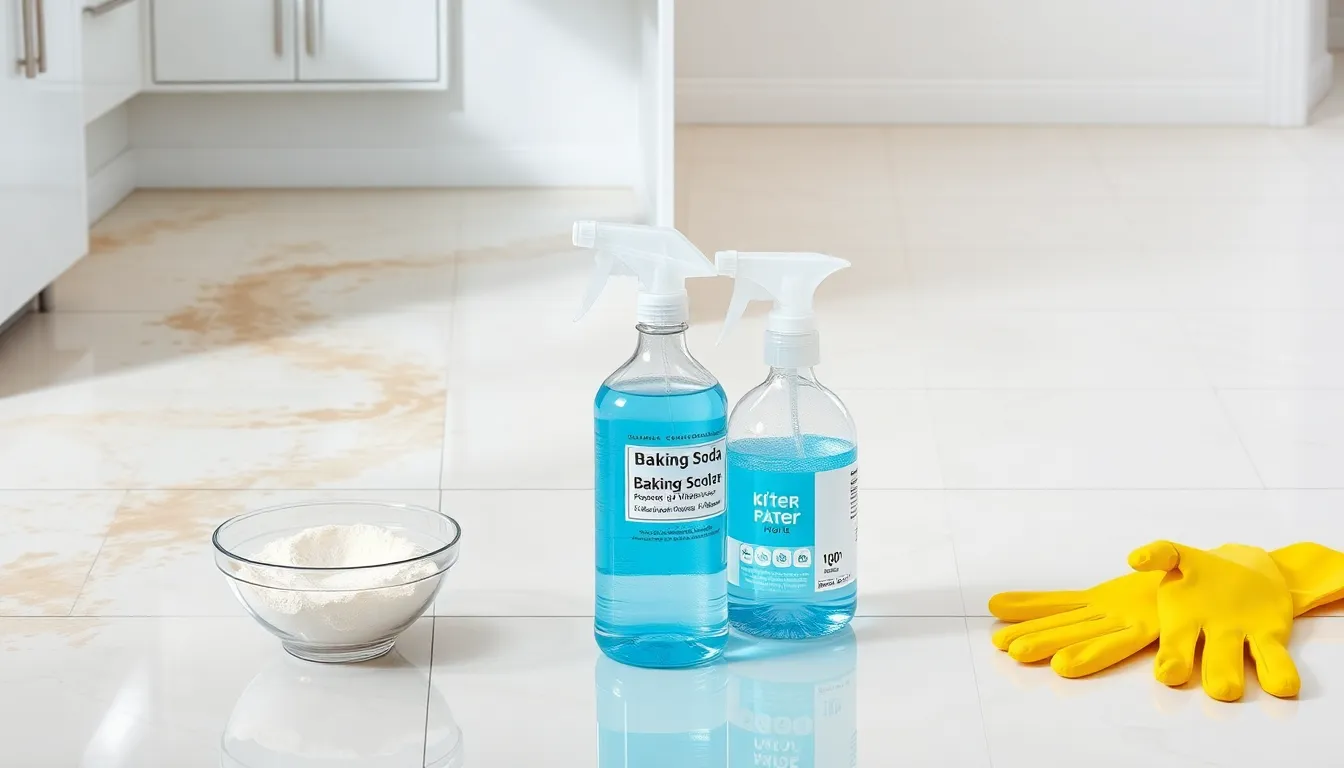Cleaning tiles can feel like a never-ending battle, especially when stubborn stains and grime refuse to budge. Enter neomanclotise remover, the superhero of tile cleaning that swoops in to save the day! If you’ve ever wished for a magic potion to restore your tiles to their former glory, you’re in luck.
Table of Contents
ToggleHow To Make Neomanclotise Remover For Tiles
Creating a neomanclotise remover for tiles requires a selection of ingredients. These components can be found in common households or sourced from specialty stores.
Common Household Items
Baking soda serves as an excellent abrasive agent, effectively lifting stains without scratching tiles. White vinegar, known for its acidity, breaks down grime and mineral deposits. Dish soap provides additional grease-cutting power, making tough stains easier to remove. Hydrogen peroxide acts as a disinfectant, enhancing cleaning efficiency. Mixing these items creates a powerful solution capable of tackling a variety of tile stains.
Specialty Chemicals
Many specialty chemicals can significantly boost cleaning capabilities. Ammonia, for example, effectively targets stubborn dirt and grease. Commercial tile cleaners often contain enzymes that break down organic stains, offering a more robust cleaning effect. Sealer removers can also strip away old sealants, restoring tiles to their original state. Carefully following the manufacturer’s instructions ensures the safest and most effective use of these chemicals.
Step-by-Step Instructions

Creating a neomanclotise remover for tiles is straightforward. Follow these instructions to prepare and apply the mixture effectively.
Preparing the Mixture
Gather the ingredients: baking soda, white vinegar, dish soap, and hydrogen peroxide. Combine one cup of baking soda with one cup of vinegar in a mixing bowl. Add a few drops of dish soap to this mixture for added cleaning power. Slowly introduce hydrogen peroxide, one cup at a time, stirring thoroughly to form a paste. Ensure the consistency is thick enough to adhere to the tiles. Store any leftover mixture in an airtight container for future use.
Application Techniques
Start by applying the mixture directly onto stained tiles using a sponge or soft cloth. Focus on heavily stained areas, ensuring even coverage. Allow the mixture to sit for at least ten minutes to break down grime. Afterward, scrub the tiles gently with a soft-bristle brush for enhanced cleaning. Rinse the tiles thoroughly with warm water, ensuring all residue is removed. Repeat the process if stains persist, adjusting the mixture as needed for tough spots.
Tips for Best Results
Achieving optimal results with neomanclotise remover depends on following key tips. Users should focus on safety and maintenance after cleaning their tiles.
Safety Precautions
Using neomanclotise remover requires careful attention to safety. Always wear gloves to protect skin from irritants. A mask can prevent inhalation of fumes from harsh chemicals. Ensure proper ventilation in the area by opening windows or using fans. Keep all ingredients out of reach of children and pets to avoid accidents. Following these precautions keeps the cleaning process safe and effective.
Maintenance of Clean Tiles
Maintaining clean tiles involves regular care and prompt stain treatment. Incorporate a routine of sweeping or vacuuming to prevent dirt buildup. Wipe up spills immediately to minimize staining risks. Consider using gentle cleaners regularly to keep tiles looking fresh. Reseal grout as needed to protect against dirt and moisture. Timely maintenance preserves the beauty and extends the life of tiles.
Troubleshooting Common Issues
Stubborn stains sometimes resist removal, even with the neomanclotise remover. Increasing the baking soda quantity can create a more abrasive paste, enhancing scrubbing power. Ensure the paste adheres well to the stained area; sometimes, adding a little more dish soap helps maintain consistency.
While applying the remover, it’s vital to allow sufficient sit time. Insufficient time may lead to ineffective results; letting it sit for 15 to 30 minutes usually offers better stain penetration. Testing a small, inconspicuous area before full application prevents unexpected damage.
Rinsing thoroughly after scrubbing is crucial to avoid residue. Residual cleaner can attract dirt and create cloudiness on tile surfaces. Using a damp cloth or mop for rinsing helps remove all traces of the remover.
Occasionally, tiles may appear dull after cleaning. In such instances, polishing with a microfiber cloth can restore shine. For tiles with serious grime buildup, consider a repeat treatment after adjusting the mixture for higher effectiveness.
If allergic reactions occur during use, stopping immediately is essential. Possible sensitivities to ingredients like vinegar or ammonia may require substituting with gentler options. Always prioritize safety by ventilating the area and wearing protective gear.
Tiles can also become slippery after treatment. A light dusting of grit or traction-enhancing powder can mitigate sliding risks. Ensuring surfaces dry properly reduces slippery conditions and enhances overall safety during cleaning.
Creating a neomanclotise remover for tiles can transform the cleaning experience and restore the beauty of tiled surfaces. By using common household ingredients and following the outlined steps, anyone can effectively tackle tough stains and grime. Safety precautions are essential to ensure a smooth cleaning process and protect health. Regular maintenance practices will help keep tiles looking pristine and prolong their lifespan. With the right approach and care, achieving sparkling clean tiles is within reach.



